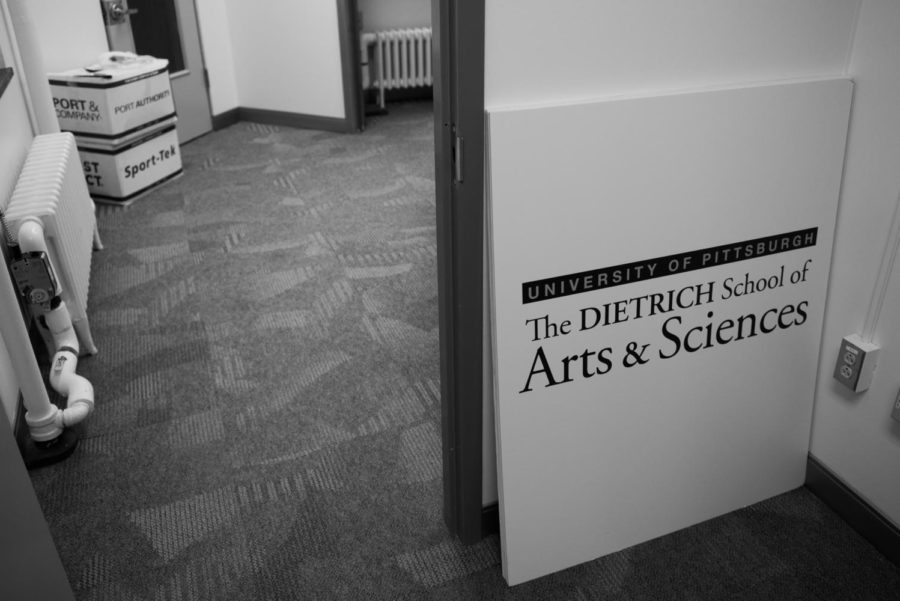Navigating humanities gen-eds in the Dietrich school
A Dietrich School of Arts and Sciences sign sits in the Cathedral of Learning in 2017.
January 19, 2022
The Dietrich School of Arts and Sciences gives its students a “liberal arts education.” Basically, that means under the formal curriculum, students are introduced to the fields and intellectual concepts of multiple disciplines — whether that be astronomy or musical theater.
This is the reason behind those perhaps pesky gen-eds of yours.
Don’t go shaking your fingers at Pitt administrators — the concept behind a liberal arts education has been around as long as the ancient Greeks, who thought that to achieve universal understanding you needed to master disciplines such as arithmetic, grammar, rhetoric and more.
John Twyning, the associate dean of undergraduate studies, is also the chair of Dietrich’s Undergraduate Council. As the official governing body for undergraduate issues, the council is made up of 12 faculty members and five students who manage gen-eds for the Dietrich school.
After more than 20 years at Pitt, Twyning said one of the best things about gen-eds is how frequently they encourage students to take on multiple majors or minors.
“I don’t think there’s a single student I’ve come across in my time who has just taken a single major which is all they would need. Taking a major and their gen-eds,” Twyning said. “Everyone is doing a double major, a major and three certificates, two majors and three certificates.”
Twyning said often students will see gen-eds as obstacles, especially if their major requires more credits. Particularly, it’s more difficult for STEM majors which tend to require more credits.
“[Students] often see the requirements as a series of hurdles to jump over to get to where they want to go. In fact, I think they’re foundational to a liberal arts degree,” Twyning said. “I think they’re foundational to all the degrees we offer, no matter what major you’re doing, no matter what discipline you’re in.”
The English department is the largest on campus in terms of courses offered, with a total of about 560. Gayle Rogers, the department’s chair, said their gen-eds are curated to have as wide of an appeal as possible.
“In the English department, we love gen-eds. We try to get as many of our courses as possible to have gen-eds whenever we can. There are some that are just naturally inclined to fit for courses that we teach,” Rogers said. “Writing-intensive is an obvious one. Literature is another obvious one. We want students from across the Dietrich school.”
Usually gen-eds under arts or creative work categories also fall under the jurisdiction of the arts and humanities departments, such as film or studio arts.
Dana Och, the film and media studies department’s director of undergraduate studies, said film courses with the “W” writing-intensive requirement are very popular among STEM students. But the department also curates classes that intersect between the STEM and humanities fields — like Technology of the Body or Disability in Film.
“Both of these classes look at how the medical field, science and technology fields talk about the body and deal with things like traumatic brain injuries or depictions of trans individuals through the medical model or the social model,” Och said.
Lenore Thomas, the chair of the studio arts department, said the department is relatively small compared to others in Dietrich and only offers one type of gen-ed.
“The studio arts department has less gen-eds in the Dietrich school. While the English department is the largest on campus, the studio arts department only offers a few gen-eds and only in one category — creative work,” Thomas said.
Studio arts offers gen-eds under the creative work requirement such as Photography 1, Drawing 1 and Sculpture 1. But that doesn’t mean that they don’t offer programs that intersect with the STEM fields.
For example, Thomas said The Beautiful Mind academic learning community combines Drawing 1, an academic foundations course and Brain and Behavior, a neuroscience course. Altogether the program is designed to look at art through the lens of neuroscience.
Thomas said despite initial hesitancy from some students taking gen-eds, many of the students in the studio arts department find themselves adding on a studio arts major or minor to their STEM degree.
“We work in what we would call studios, but in science, they might refer to it as labs. But there’s a real similar move through and thinking through how we connect those spaces,” Thomas said “And the way we think, to get from one end to another end, right? So we’re both problem solving. But how we get to those ends might be different.”
Och said she’s spoken with STEM majors, particularly those who are on a pre-med track, who found it easier to connect with patients after taking humanities classes.
“I have had multiple students go on to medical school, for example, and they tell me how their work in media courses or anthropology courses or psychology courses allow them to make connections to their patients. This is such a strong element of your training at Pitt,” Och said.
Whether or not you pursue a gen-ed’s discipline further after finishing the class, Rogers said these classes are an essential part of the college experience, and if nothing else, gen-eds help students figure out what they don’t want to pursue after graduation.
“I encourage students to not be afraid to stumble and be challenged and be okay with the fact that you’re going to go into something that you were traumatized by in high school,” Rogers said. “And it was chemistry for me when I got to college. I just had a miserable experience with it and that’s good. That’s why I’m not a chemist, but that’s what you got to figure out.”



